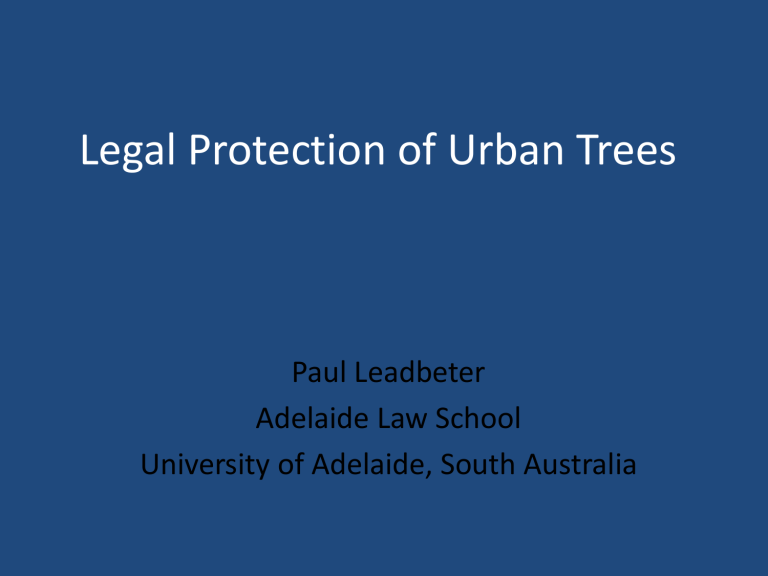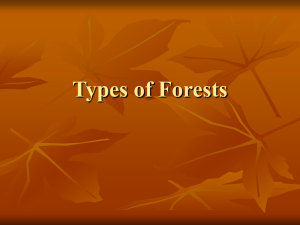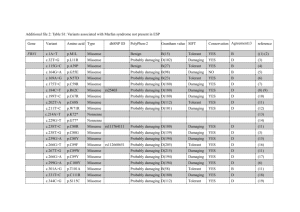Legal Protection of Urban Trees

Legal Protection of Urban Trees
Paul Leadbeter
Adelaide Law School
University of Adelaide, South Australia
Urban trees- ‘natural air conditioner for the city’
What are ‘urban trees’
• Trees growing within a town or city as opposed to trees growing in a rural setting
• Peri- urban areas?- transitioning areas create questions
• Should include trees on both public and private land
Why protect urban trees?
• Number of reasons:
1. Reduces the ‘urban heat island effect’
2. Provision of shade &aesthetic improvements to streetscapes
3. Privacy
4. Shelter for humans & animals during inclement weather
5. Contribution to biodiversity
Contribution to biodiversity
Koala in Urban tree in Adelaide
How can we protect urban trees?
• Identify urban trees ( list or define them)
• Make removal or damaging of them something requiring approval
• Is land use planning legislation the ideal mechanism for legal protection?
What trees should be protected?
• Range of possible criteria for protected status:
1. Species of tree
2. Tree’s size
3. Tree’s location
4. Tree’s cultural or heritage significance
5. Aesthetic or urban design reasons
• In South Australia size of tree, its location, its position re buildings and its species are all factors influencing whether a tree has a protected status
• Should any trees not be protected? Eg pest plants, woodlots, orchards, other plantations, non indigenous?
What is tree damaging activity?
• In South Australia broadly defined to include: a) The killing or destruction of a tree; or b) The removal of a tree; or c) The severing of branches, limbs, stems or trunk of a tree; or d) The ringbarking, topping or lopping of a tree; or e) Any other substantial damage to a tree but not
‘maintenance pruning’ ( removal of less than 30% of tree’s crown for purposes of removing dead or diseased wood or preventing risks to human safety or damage to buildings)
Relevant factors when assessing applications for tree damaging activity?
• Is tree diseased or has short life expectancy?
• Does it pose material risk to public or private safety?
• Is tree causing damage to a building?
• Is work in general interests of tree’s health?
• Have all reasonable alternative development options & design solutions been considered to prevent substantial tree damaging activity occurring?
Consequences for persons who damage trees without authorisation?
• In South Australia options include:
1. Prosecution and financial penalty
2. Court orders in nature of injunctive relief
3. Make good orders ( eg remove buildings, structures, plantings, plant replacement trees
& nurture to maturity)
Potential problems with tree protection systems?
1. Conflict between urban consolidation & tree retention.
2. Impacts of trees on buildings, public and private infrastructure eg drains , roads and footpaths
3. Inappropriate plantings
4. Unlawful & surreptitious tree damaging activities
5. Public liability concerns
Inappropriate plantings
Tasmanian Blue gum ( Eucalyptus globulus) in South Australian suburban backyard- healthy tree, limb dropper , totally inappropriate in suburban context
4.Unlawful and surreptitious tree damaging activities
Trees pre Poisoning
Trees some months after poisoning
Conclusions
• Trees play important role in reducing urban temperatures
• Useful and cheap adaptation measure
• Greatest risks for urban trees come from development & urban consolidation
• Legal protection via land use planning laws & policies is important
• Essential laws have defined criteria for listing, damaging or removing, and recognition of potential risks to human safety and building and infrastructure integrity









